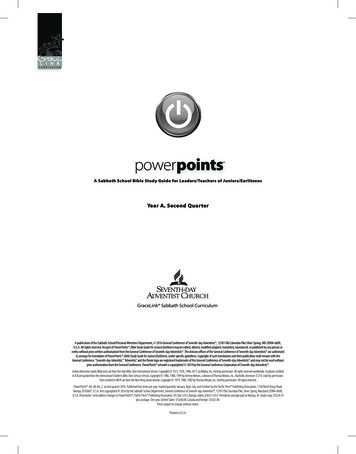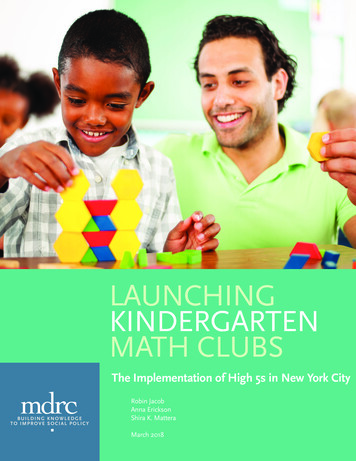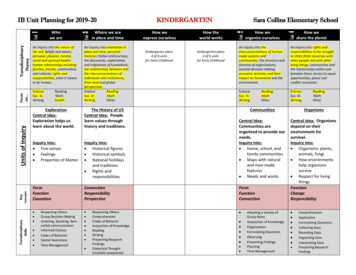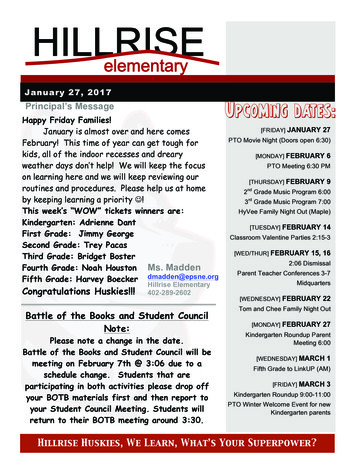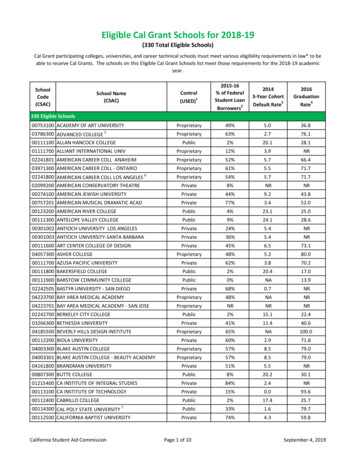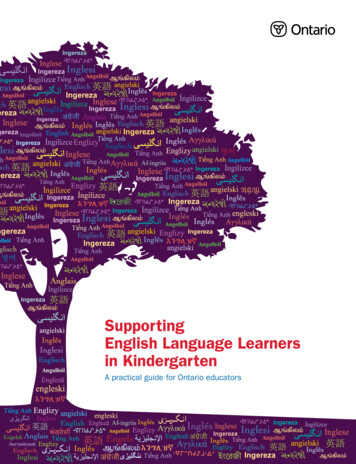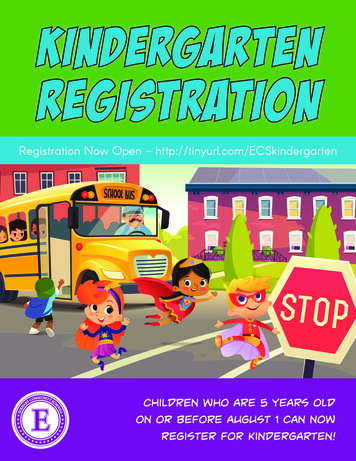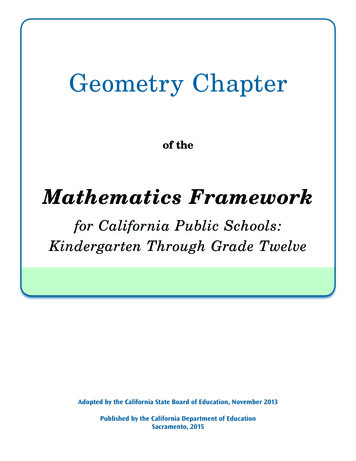
Transcription
Geometry Chapterof theMathematics Frameworkfor California Public Schools:Kindergarten Through Grade TwelveAdopted by the California State Board of Education, November 2013Published by the California Department of EducationSacramento, 2015
GeometryThe fundamental purpose of the Geometry course isto introduce students to formal geometric proofs andthe study of plane figures, culminating in the studyof right-triangle trigonometry and circles. Students beginto formally prove results about the geometry of the planeby using previously defined terms and notions. Similarity isexplored in greater detail, with an emphasis on discoveringtrigonometric relationships and solving problems with righttriangles. The correspondence between the plane and theCartesian coordinate system is explored when students connect algebra concepts with geometry concepts. Students explore probability concepts and use probability in real-worldAlgebra IIsituations. The major mathematical ideas in the Geometrycourse include geometric transformations, proving geometric theorems, congruence and similarity, analytic geometry,right-triangle trigonometry, and probability.GeometryThe standards in the traditional Geometry course come fromthe following conceptual categories: Modeling, Geometry,and Statistics and Probability. The content of the course isexplained below according to these conceptual categories, butAlgebra Iteachers and administrators alike should note that the standards are not listed here in the order in which they shouldbe taught. Moreover, the standards are not topics to bechecked off after being covered in isolated units of instruction; rather, they provide content to be developed throughoutthe school year through rich instructional experiences.California Mathematics FrameworkGeometry447
What Students Learn in GeometryAlthough there are many types of geometry, school mathematics is devoted primarily to plane Euclidean geometry, studied both synthetically (without coordinates) and analytically (with coordinates). In thehigher mathematics courses, students begin to formalize their geometry experiences from elementaryand middle school, using definitions that are more precise and developing careful proofs. The standards for grades seven and eight call for students to see two-dimensional shapes as part of a genericplane (i.e., the Euclidean plane) and to explore transformations of this plane as a way to determinewhether two shapes are congruent or similar. These concepts are formalized in the Geometry course,and students use transformations to prove geometric theorems. The definition of congruence in termsof rigid motions provides a broad understanding of this means of proof, and students explore the consequences of this definition in terms of congruence criteria and proofs of geometric theorems.Students investigate triangles and decide when they are similar—and with this newfound knowledgeand their prior understanding of proportional relationships, they define trigonometric ratios and solveproblems by using right triangles. They investigate circles and prove theorems about them. Connectingto their prior experience with the coordinate plane, they prove geometric theorems by using coordinates and describe shapes with equations. Students extend their knowledge of area and volume formulas to those for circles, cylinders, and other rounded shapes. Finally, continuing the developmentof statistics and probability, students investigate probability concepts in precise terms, including theindependence of events and conditional probability.Examples of Key Advances from Previous Grade Levels orCourses Because concepts such as rotation, reflection, and translation were treated in the grade-eightstandards mostly in the context of hands-on activities and with an emphasis on geometric intuition, the Geometry course places equal weight on precise definitions. In kindergarten through grade eight, students worked with a variety of geometric measures:length, area, volume, angle, surface area, and circumference. In Geometry, students apply thesecomponent skills in tandem with others in the course of modeling tasks and other substantialapplications (MP.4). The skills that students develop in Algebra I around simplifying and transforming square rootswill be useful when solving problems that involve distance or area and that make use of thePythagorean Theorem. Students in grade eight learned the Pythagorean Theorem and used it to determine distances ina coordinate system (8.G.6–8). In Geometry, students build on their understanding of distancein coordinate systems and draw on their growing command of algebra to connect equationsand graphs of circles (G-GPE.1). The algebraic techniques developed in Algebra I can be applied to study analytic geometry.Geometric objects can be analyzed by the algebraic equations that give rise to them. Algebracan be used to prove some basic geometric theorems in the Cartesian plane.448GeometryCalifornia Mathematics Framework
Connecting Mathematical Practices and ContentThe Standards for Mathematical Practice (MP) apply throughout each course and, together with thecontent standards, prescribe that students experience mathematics as a rigorous, coherent, useful, andlogical subject. The Standards for Mathematical Practice represent a picture of what it looks like forstudents to do mathematics and, to the extent possible, content instruction should include attention toappropriate practice standards. The Geometry course offers ample opportunities for students to engagewith each MP standard; table G-1 offers some examples.Table G-1. Standards for Mathematical Practice—Explanation and Examples for GeometryStandards for MathematicalPracticeMP.1Make sense of problems and persevere in solving them.Explanation and ExamplesStudents construct accurate diagrams of geometry problems to helpmake sense of them. They organize their work so that others can follow their reasoning (e.g., in proofs).MP.2Students understand that the coordinate plane can be used to repreReason abstractly and quantitatively. sent geometric shapes and transformations, and therefore they connect their understanding of number and algebra to geometry.MP.3Students reason through the solving of equations, recognizing thatsolving an equation involves more than simply following rote rules andConstruct viable arguments and, then” whensteps. They use language such as “Ifcritique the reasoning of others.Students build proofs by induction explaining their solution methods and provide justification for theirand proofs by contradiction. CA 3.1 reasoning.(for higher mathematics only).MP.4Model with mathematics.MP.5Use appropriate tools strategically.MP.6Attend to precision.MP.7Look for and make use of structure.MP.8Look for and express regularity inrepeated reasoning.Students apply their new mathematical understanding to real-worldproblems. They learn how transformational geometry and trigonometry can be used to model the physical world.Students make use of visual tools for representing geometry, such assimple patty paper, transparencies, or dynamic geometry software.Students develop and use precise definitions of geometric terms. Theyverify that a particular shape has specific properties and justify thecategorization of the shape (e.g., a rhombus versus a quadrilateral).Students construct triangles in quadrilaterals or other shapes and usecongruence criteria of triangles to justify results about those shapes.Students explore rotations, reflections, and translations, noticing thatsome attributes of shapes (e.g., parallelism, congruency, orientation)remain the same. They develop properties of transformations by generalizing these observations.Standard MP.4 holds a special place throughout the higher mathematics curriculum, as Modeling isconsidered its own conceptual category. Although the Modeling category does not include specific stanCalifornia Mathematics FrameworkGeometry449
dards, the idea of using mathematics to model the world pervades all higher mathematics courses andshould hold a high place in instruction. Some standards are marked with a star ( ) symbol to indicatethat they are modeling standards—that is, they may be applied to real-world modeling situations moreso than other standards.In places where specific MP standards may be implemented with the geometry standards, the MP standards are noted in parentheses.Geometry Content Standards, by Conceptual CategoryThe Geometry course is organized by conceptual category, domains, clusters, and then standards. Theoverall purpose and progression of the standards included in the Geometry course are described below,according to each conceptual category. Standards that are considered new for secondary-grades teachersare discussed more thoroughly than other standards.Conceptual Category: ModelingThroughout the California Common Core State Standards for Mathematics (CA CCSSM), specific standardsfor higher mathematics are marked with a symbol to indicate they are modeling standards. Modelingat the higher mathematics level goes beyond the simple application of previously constructed mathematics and includes real-world problems. True modeling begins with students asking a question about theworld around them, and the mathematics is then constructed in the process of attempting to answer thequestion. When students are presented with a real-world situation and challenged to ask a question, allsorts of new issues arise: Which of the quantities present in this situation are known and which are unknown? What can I generalize? Is there some way to introduce into this diagram a known shape that givesmore information? Students need to decide on a solution path, which may need to be revised. They makeuse of tools such as calculators, dynamic geometry software, or spreadsheets. They validate their work bymoving between calculations done by hand and software-assisted computations.Modeling problems have an element of being genuine problems, in the sense that students care about answering the question under consideration. In modeling, mathematics is used as a tool to answer questionsthat students really want answered. Students examine a problem and formulate a mathematical model (anequation, table, graph, and the like), compute an answer or rewrite their expression to reveal new information, interpret and validate the results, and report out; see figure G-1. This is a new approach for manyteachers and may be challenging to implement, but the effort should show students that mathematicsis relevant to their lives. From a pedagogical perspective, modeling gives a concrete basis from which toabstract the mathematics and often serves to motivate students to become independent learners.Figure G-1. The Modeling erpretReportCalifornia Mathematics Framework
The examples in this chapter are framed as much as possible to illustrate the concept of mathematicalmodeling. The important ideas of proving geometric theorems, congruence and similarity, analyticgeometry, right-triangle trigonometry, and probability can be explored in this way. Readers are encouraged to consult appendix B (Mathematical Modeling) for further discussion of the modeling cycle andhow it is integrated into the higher mathematics curriculum.Conceptual Category: GeometryA large portion of instruction in the traditional Geometry course is formed by the standards of theGeometry conceptual category. Here, students develop the ideas of congruence and similarity throughtransformations. They prove theorems, both with and without the use of coordinates. They exploreright-triangle trigonometry, as well as circles and parabolas. Standard MP.3, “Construct viable arguments and critique the reasoning of others,” with the California addition MP.3.1 (“Students build proofsby induction and proofs by contradiction”), plays a predominant role throughout the Geometry course.CongruenceG-COExperiment with transformations in the plane.1. Know precise definitions of angle, circle, perpendicular line, parallel line, and line segment, based on theundefined notions of point, line, distance along a line, and distance around a circular arc.2. Represent transformations in the plane using, e.g., transparencies and geometry software; describe transformations as functions that take points in the plane as inputs and give other points as outputs. Comparetransformations that preserve distance and angle to those that do not (e.g., translation versus horizontalstretch).3. Given a rectangle, parallelogram, trapezoid, or regular polygon, describe the rotations and reflectionsthat carry it onto itself.4. Develop definitions of rotations, reflections, and translations in terms of angles, circles, perpendicularlines, parallel lines, and line segments.5. Given a geometric figure and a rotation, reflection, or translation, draw the transformed figure using,e.g., graph paper, tracing paper, or geometry software. Specify a sequence of transformations that willcarry a given figure onto another.Understand congruence in terms of rigid motions. [Build on rigid motions as a familiar starting point fordevelopment of concept of geometric proof.]6. Use geometric descriptions of rigid motions to transform figures and to predict the effect of a given rigidmotion on a given figure; given two figures, use the definition of congruence in terms of rigid motions todecide if they are congruent.7. Use the definition of congruence in terms of rigid motions to show that two triangles are congruent if andonly if corresponding pairs of sides and corresponding pairs of angles are congruent.8. Explain how the criteria for triangle congruence (ASA, SAS, and SSS) follow from the definition of congruence in terms of rigid motions.In geometry, the commonly held (but imprecise) definition that shapes are congruent when they “havethe same size and shape” is replaced by a more mathematically precise one (MP.6): Two shapes arecongruent if there is a sequence of rigid motions in the plane that takes one shape exactly onto the other.California Mathematics FrameworkGeometry451
This definition is explored intuitively in the grade-eight standards, but in the Geometry course it isinvestigated more closely. In grades seven and eight, students experimented with transformations inthe plane; however, the Geometry course requires that students build more precise definitions for therigid motions (rotation, reflection, and translation) based on previously defined and understood termssuch as point, line, between, angle, circle, perpendicular, and so forth (G-CO.1, 3–4). Students base theirunderstanding of these definitions on their experience with transforming figures using patty paper,transparencies, or geometry software (G-CO.2–3, 5; MP.5), something they started doing in gradeeight. These transformations should be investigated both in a general plane as well as on a coordinatesystem—especially when transformations are explicitly described by using precise names of points,translation vectors, and lines of symmetry or reflection.Example: Defining RotationsG-CO.4Mrs. B wants to help her class understand the following definition of a rotation:A rotation about a point throughangle is a transformationsuch that (1) if point is differentand the measurefrom , then ; and (2) if point is theofsame as point , then.Mrs. B gives her students a handout with several geometric shapes on it and a point, , indicated on thepage. In pairs, students copy the shapes onto a transparency sheet and rotate them through various anglesabout ; then they transfer the rotated shapes back onto the original page and measure various lengths andangles as indicated in the definition.While justifying that the properties of the definition hold for the shapes given to them by Mrs. B, the students also make some observations about the effects of a rotation on the entire plane. For example: Rotations preserve lengths. Rotations preserve angle measures. Rotations preserve parallelism.In a subsequent exercise, Mrs. B plans to allow students to explore more rotations on dynamic geometrysoftware, asking them to create a geometric shape and rotate it by various angles about various points, bothpart of the object and not part of the object.In standards G-CO.6–8, geometric transformations are given a more prominent role in the highermathematics geometry curriculum than perhaps ever before. The new definition of congruence in termsof rigid motions applies to any shape in the plane, whereas previously, congruence seemed to dependon criteria that were specific only to particular shapes. For example, the side–side–side (SSS) congruence criterion for triangles did not extend to quadrilaterals, which seemed to suggest that congruencewas a notion dependent on the shape that was considered. Although it is true that there are specificcriteria for determining congruence of certain shapes, the basic notion of congruence is the same for allshapes. In the CA CCSSM, the SSS criterion for triangle congruence is a consequence of the definition of452GeometryCalifornia Mathematics Framework
congruence, just as the fact that if two polygons are congruent, then their sides and angles can be putinto a correspondence such that each corresponding pair of sides and angles is congruent. This conceptcomprises the content of standards G-CO.7 and G-CO.8, which derive congruence criteria for trianglesfrom the new definition of congruence.Standard G-CO.7 explicitly states that students show that two triangles are congruent if and only ifcorresponding pairs of sides and corresponding pairs of angles are congruent (MP.3). The depth of reasoning here is fairly substantial, as students must be able to show, using rigid motions, that congruenttriangles have congruent corresponding parts and that, conversely, if the corresponding parts of twotriangles are congruent, then there is a sequence of rigid motions that takes one triangle to the other.The second statement may be more difficult to justify than the first for most students, so a justificationis presented here. Suppose there are two trianglesandsuch that the correspondence,,resultsin pairs of sides and pairs ofFigure G-2. Illustration of the Reasoning That Congruentangles being congruent. If oneCorresponding Parts Imply Triangle Congruencetriangle were drawn on a fixedBpiece of paper and the otherdrawn on a separate transCEparency, then a student couldillustrate a translation, , thattakes point to point . Asimple rotation about pointF, if necessary, takes pointAto point , which is certain toDoccur becauseandrotations preserve lengths.Point is translated to , the resulting image ofis rotated so as to place onto, and the image is then reflected along line segmentto match point to .A final step that may be needed is a reflection about theside , to take point topoint . It is important to note why the image of point is actually . Sinceis reflected about line, its measure is preserved. Therefore, the image of sideat least lies on line, since.But since, it must be the case that the image of point coincides with . The previous discussion amounts to the fact that the sequence of rigid motions, , followed by , followed by , mapsexactly onto. Therefore, if it is known that the corresponding parts of two triangles arecongruent, then there is a sequence of rigid motions carrying one onto the other; that is, they are congruent. The informal proof presented here should be accessible to students in the Geometry course; seefigure G-2.Similar reasoning applies for standard G.CO.8, in which students justify the typical triangle congruencecriteria such as ASA, SAS, and SSS. Experimentation with transformations of triangles where only twoof the criteria are satisfied will result in counterexamples, and geometric constructions of triangles ofprescribed side lengths (e.g., in the case of SSS) will leave little doubt that any triangle constructed withthese side lengths will be congruent to another, and therefore that SSS holds (MP.7).California Mathematics FrameworkGeometry453
CongruenceG-COProve geometric theorems. [Focus on validity of underlying reasoning while using variety of ways of writingproofs.]9. Prove theorems about lines and angles. Theorems include: vertical angles are congruent; when a transversalcrosses parallel lines, alternate interior angles are congruent and corresponding angles are congruent; pointson a perpendicular bisector of a line segment are exactly those equidistant from the segment’s endpoints.10. Prove theorems about triangles. Theorems include: measures of interior angles of a triangle sum to 180 ;base angles of isosceles triangles are congruent; the segment joining midpoints of two sides of a triangle isparallel to the third side and half the length; the medians of a triangle meet at a point.11. Prove theorems about parallelograms. Theorems include: opposite sides are congruent, opposite angles arecongruent, the diagonals of a parallelogram bisect each other, and conversely, rectangles are parallelogramswith congruent diagonals.Make geometric constructions. [Formalize and explain processes.]12. Make formal geometric constructions with a variety of tools and methods (compass and straightedge,string, reflective devices, paper folding, dynamic geometric software, etc.). Copying a segment; copying anangle; bisecting a segment; bisecting an angle; constructing perpendicular lines, including the perpendicularbisector of a line segment; and constructing a line parallel to a given line through a point not on the line.13. Construct an equilateral triangle, a square, and a regular hexagon inscribed in a circle.It is important to note that when the triangle criteria for congruence are established, students canbegin to prove geometric theorems. Examples of such theorems are listed in standards G.CO.9–11. Thetriangle congruence criteria are established results that can be used to prove new results. Instructorsare encouraged to use a variety of strategies for engaging students to understand and write proofs,such as using numerous pictures to demonstrate results and generate strategies; using patty paper,transparencies, or dynamic geometry software to explore the steps in a proof; creating flowcharts andother organizational diagrams for outlining a proof; and writing step-by-step or paragraph formatsfor a completed proof (MP.5). Above all else, instructors should emphasize the reasoning involvedin connecting one step in the logical argument to the next. Students should be encouraged to makeconjectures based on experimentation, to justify their conjectures, and to communicate their reasoningto their peers (MP.3). The following example illustrates how students can be encouraged to experimentand construct hypotheses based on their observations.454GeometryCalifornia Mathematics Framework
Example: The Kite FactoryG.CO.11Kite engineers want to know how the shape of a kite—the length of the rods, where they are attached, theangle at which the rods are attached, and so on—affects how the kite flies. In this activity, students are givenpieces of cardstock of various lengths, hole-punched at regular intervalsso they can be attached in different places.These two “rods” form the frame for a kite at the kite factory. By changingthe angle at which the sticks are held and the places where the sticks areattached, students discover different properties of quadrilaterals.Students are challenged to make conjectures and use precise language todescribe their findings about which diagonals result in which quadrilaterals. They can discover propertiesunique to certain quadrilaterals, such as the fact that diagonals that are perpendicular bisectors of each otherimply the quadrilateral is a rhombus. To see videos of this lesson being implemented in a high school classroom, visit http://www.insidemathematics.org/ (accessed March 26, 2015).Similarity, Right Triangles, and TrigonometryG-SRTUnderstand similarity in terms of similarity transformations.1. Verify experimentally the properties of dilations given by a center and a scale factor:a. A dilation takes a line not passing through the center of the dilation to a parallel line, and leaves aline passing through the center unchanged.b. The dilation of a line segment is longer or shorter in the ratio given by the scale factor.2. Given two figures, use the definition of similarity in terms of similarity transformations to decide if theyare similar; explain using similarity transformations the meaning of similarity for triangles as the equalityof all corresponding pairs of angles and the proportionality of all corresponding pairs of sides.3. Use the properties of similarity transformations to establish the Angle–Angle (AA) criterion for two triangles to be similar.Prove theorems involving similarity.4. Prove theorems about triangles. Theorems include: a line parallel to one side of a triangle divides the othertwo proportionally, and conversely; the Pythagorean Theorem proved using triangle similarity.5. Use congruence and similarity criteria for triangles to solve problems and to prove relationships in geometric figures.Because right triangles and triangle relationships play such an important role in applications andfuture mathematics learning, they are given a prominent role in the Geometry conceptual category. Adiscussion of similarity is necessary first—and again, a more precise mathematical definition of similarity is given in the higher mathematics standards. Students worked with dilations as a transformationin the grade-eight standards; now they explore the properties of dilations in more detail and developan understanding of the notion of scale factor (G-SRT.1). Whereas it is common to say that objects thatare similar have “the same shape,” the new definition for two objects being similar is that there is asequence of similarity transformations—translation, rotation, reflection, or dilation—that maps oneobject exactly onto the other. Standards G-SRT.2 and G-SRT.3 call for students to explore the consequences of two triangles being similar: that they have congruent angles and that their side lengths arein the same proportion. This new understanding gives rise to more results that are encapsulated instandards G-SRT.4 and G-SRT.5.California Mathematics FrameworkGeometry455
Example: Experimenting with DilationsG-SRT.2–3Students are given opportunities to experiment with dilations and determine how they affect planar objects.with center as the transformationStudents first make sense of the definition of a dilation of scale factorthat moves a point along the rayto a new point , so that. For example, using a ruler,students apply the dilation of scale factor 2.5 with center to the points , , and illustrated below. Oncethis is done, the students consider the two trianglesand, and they discover that the lengths ofthe corresponding sides of the triangles have the same ratio dictated by the scale factor (G-SRT.2).Students learn that parallel lines are taken to parallel lines by dilations; thus corresponding segments ofandare parallel. After students have proved results about parallel lines intersected by a transversal, they can deduce that the angles of the triangles are congruent. Through experimentation, they see thatthe congruence of corresponding angles is a necessary and sufficient condition for the triangles to be similar,criterion for triangle similarity (G.SRT.3).leading to theAPBCFor a simple investigation, students can observe how the distance at which a projector is placed from a screenaffects the size of the image on the screen (MP.4).Similarity, Right Triangles, and TrigonometryG-SRTDefine trigonometric ratios and solve problems involving right triangles.6. Understand that by similarity, side ratios in right triangles are properties of the angles in the triangle,leading to definitions of trigonometric ratios for acute angles.7. Explain and use the relationship between the sine and cosine of complementary angles.8. Use trigonometric ratios and the Pythagorean Theorem to solve right triangles in applied problems. 8.1 Derive and use the trigonometric ratios for special right triangles (30 , 60 , 90 and 45 , 45 , 90 ). CAOnce the angle–angle ( ) similarity criterion for triangles is established, it follows that any two righttrianglesandare similar when at least one pair of angles are congruent (say),since the right angles are obviously congruent (say). By similarity, the corresponding sides ofthe triangles are in proportion:456GeometryCalifornia Mathematics Framework
Notice the first and third expressions in the statement of equality above can be rearranged to yieldthat:.Since the triangles in question are arbitrary, this implies that for any right triangle with an angle congruent to, the ratio of the side opposite toand the hypotenuse of the triangle is a certainconstant. This allows us to define unambiguously the sine of, denoted by, as the value of thisratio. In this way, students come to understand the trigonometric functions as relationships completelydetermined by angles (G-SRT.6). They further their understanding of these functions by investigatingrelationships between sine, cosine, and tangent; by exploring the relationship between the sine andcosine of complementary angles; and by applying their knowledge of right triangles to real-world situations (MP.4), such as in the example below (G-SRT.6–8). Experience working with many different triangles, finding their measurements, and computing ratios of the measurements found will help studentsunderstand the basics of the trigonometric functions.Example: Using Trigonometric RelationshipsG-SRT.6–8Airplanes that travel at high speeds and low elevations often have onboard radar systems to detect possibleobstacles in their path. The radar can determine the range of an obstacle and the angle of elevation to thetop of the obstacle. Suppose tha
nect algebra concepts with geometry concepts. Students ex-plore probability concepts and use probability in real-world situations. The major mathematical ideas in the Geometry course include geometric transformations, proving geomet-ric theorems, congruence and similarity, analytic geometry
